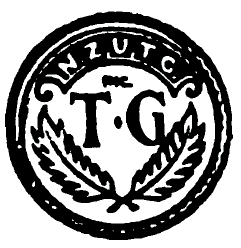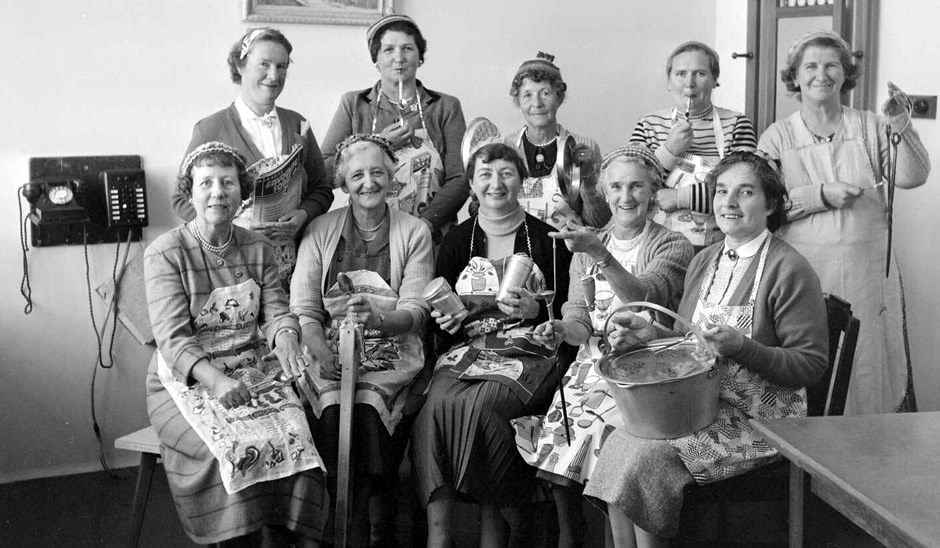This essay written by Fiona McKergow was first published in Women Together: a History of Women's Organisations in New Zealand in 1993. It was updated by Fiona McKergow in 2018.
1932–1993
The Dominion Federation of Townswomen's Guilds (DFTG) aimed to educate women and to encourage 'their development as citizens'. [1] Town- and city-based guilds were open to all women 'irrespective of creed, party and race', although they attracted mostly older Pākehā women. [2] In 1992 there were 41 guilds with a combined membership of 1900.
Townswomen's guilds originated in Britain in 1929 as an urban counterpart to the Women’s Institutes (WI), which preferred to maintain their separate character as rural organisations. The British campaign for universal equal suffrage for women during the mid-1920s had also created a demand for greater educational, civic and social opportunities for urban women. About 150 British guilds joined the National Union of Townswomen's Guilds when it formed in 1933.
The first townswomen's guild in New Zealand was established by Anna Elizabeth Jerome Spencer in Napier in 1932, with the support of Amy Hutchinson and the local Women’s Institutes. It was intended to bring local women together for mutual help and 'the restoration of civic and social interests', following the 1931 earthquake. [3] The inaugural meeting was held in one of the few remaining public halls in May 1932, and over 200 women joined.
By mid-1935 townswomen's guilds had been established in Hastings, Dannevirke, Palmerston North and Nelson. They aimed to stimulate and entertain their members with a varied programme of lectures and demonstrations at monthly meetings. Topics focused on the home and community; local and national affairs, including housing, health and education; and a wide range of cultural and recreational interests. The activities of individual guilds were reported in a monthly journal, The Townswoman, produced from 1933 by the Napier guild and later by the DFTG.
Each guild set up small groups or circles to give members the opportunity to extend themselves in particular areas. Arts and crafts, music, drama and literature, and gardening circles were among the most popular, while floral art, civic and bridge circles also attracted keen members. Among the more unusual was an exploring circle, formed in Christchurch in 1954. Charitable work, fundraising and other community services, such as beautifying towns through planting schemes, were encouraged.
The first national body, the New Zealand Union of Townswomen's Guilds (NZUTG), was established in Wellington in 1937 under the leadership of Mary Pow. In 1938 two opposing factions developed at the annual council meeting; key members of the council allegedly refused to abide by the constitution and rules adopted the previous year, and an acute division arose over the election of a new executive committee.
The Dominion Federation of Townswomen's Guilds was formed as a breakaway group by delegates from 13 guilds, with Jerome Spencer as president (1938-44). Mary Pow continued to lead the NZUTG, which initially consisted of guilds from Nelson West, Wellington Central, Miramar, Eastbourne and Palmerston North.
By 1940 both national bodies had turned their attention to the war effort. Members were urged to help other organisations, such as the Red Cross Society and Lady Galway Patriotic Guilds. Many guilds turned their arts and crafts circles into patriotic sewing circles, span and knitted scarves, gloves and caps for servicemen overseas, and collected clothes for refugees. Other guilds made camouflage nets, papier mâché hospital supplies and Red Cross supplies, and provided hospitality to men in local army camps. In 1939 the Dunedin branch of the NZUTG involved 80 members in training for motorcar servicing and work in hospital kitchens and linen rooms, in addition to a community aid service for soldiers' wives. Both organisations grew rapidly and continued to develop along separate but parallel lines. [4]
In 1943 the DFTG formed its first area federations, in Wellington (seven guilds) and Hawke's Bay (six guilds). These provided a link between individual guilds and the national body, and co-ordinated regional activities such as annual handcraft exhibitions. Each national executive was made up of representatives from guilds in widely scattered regions. The DFTG operated mainly through its conferences, held annually from 1939 and later biennially. Remits discussed at conferences ranged from opposition to the sale of fireworks to children, and to the legalisation of marijuana, to support for medical clinics for women, and for greater female representation in local government.
From 1962 the DFTG co-ordinated national fundraising schemes, beginning with £596 toward cancer research in 1962 and £1450 for the Freedom from Hunger campaign in 1963. Generous sums were donated for research and other purposes to organisations such as the National Heart Foundation, the Arthritis Foundation and the New Zealand Asthma Society. Other major projects involved making or collecting garments for CORSO and the Salvation Army. Many guilds also undertook local fundraising schemes.
By 1973 the DFTG consisted of 96 guilds. Two decades later, despite its declining membership, the DFTG continued to foster its ideals of education and good citizenship, and guilds remained active. In the early 1990s, for instance, local guild events included entertaining the elderly in rest homes in Mount Maunganui, a talk on Civil Defence in Royal Oak, and a trip to a West Auckland vineyard by Blockhouse Bay. Townswomen's guilds continued to offer their members companionship and the opportunity to learn new skills and contribute to their community.
Fiona McKergow
1994–2018
By the late 1990s the DFTG was facing a membership crisis; it disbanded as a national organisation in 2001. [5] Individual guilds continued as social groups, but communication between them ceased. Christchurch was apparently the last centre of activity, with two guilds remaining prior to the 2010 Canterbury and 2011 Christchurch earthquakes. The Dallington guild wound up in the aftermath of the earthquakes, and the Linwood guild had a final meeting to celebrate its 71st anniversary in April 2018. [6] An outward-looking commitment to female citizenship had waned. It had become a ‘fellowship of ladies’ who cared for each other through shared activities, such as games of scrabble and potluck lunches. [7] Officeholders were in short supply as members became too elderly to take on such responsibilities.
A parallel demise had not occurred in Britain, where townswomen’s guilds originated. Proud of their founder, suffrage campaigner Margery Corbett-Ashby, British townswomen’s guilds continued to foster a form of female citizenship that incorporated a strand of activism. [8] While fundraising events and monthly meetings with speakers, demonstrations and social activities were an ongoing feature of British guild membership, there were also campaigns to address issues of national and international significance, including child trafficking, under-age marriage, contemporary slavery, asbestos in schools, and fracking. [9] Associate membership was offered to women in paid employment who could not attend guild meetings, an accommodation New Zealand townswomen chose not to make. [10]
In 2018 there may still have been remnant groups of townswomen in this country continuing to meet informally for companionship. Some former townswomen joined urban branches of the New Zealand Federation of Women’s Institutes. [11] Newer groups, such as chapters of the Red Hat Society, established in California in 1998, also provided social outlets for older, urban women. [12] They did not, however, have the resolute focus on education and citizenship that had motivated earlier generations of townswomen.
Fiona McKergow
Notes
[1] Dominion Federation of Townswomen's Guilds Constitution and Rules, issued March 1956.
[2] Dominion Federation of Townswomen's Guilds Annual Report, 1943.
[3] Letter from A.E. Jerome Spencer to Mrs Brodie, 2 August 1942.
[4] In 1949 the NZUTG voted strongly against possible amalgamation with the DFTG. The NZUTG went into recess when its last branch in Dunedin disbanded in 1981.
[5] Perrott, Alan, ‘Townswomen’s guilds face membership crisis’, East and Bays Courier, 3 April 1998, p. 7. For date DFTG disbanded, see Nelson Townswomen’s Guild records, 1935–2002, AG-287, Nelson Provincial Museum, available at: http://thecommunityarchive.org.nz/node/71524/description; also confirmed in conversation with Ina Dunstan, last treasurer of DFTG, 26 September 2018.
[6] Conversation with Ina Dunstan, last president of Dallington Townswomen’s Guild, 26 September 2018; Conversation with Nancy van den Ende, last president of the Linwood Townswomen’s Guild, 13 September 2018; Email to Fiona McKergow from Lea Gilmore, 26 June 2018.
[7] Conversation with Nancy van den Ende, last president of the Linwood Townswomen’s Guild, 13 September 2018.
[8] ‘History – Margery Corbett-Ashby’ at: https://www.the-tg.com/history-dame-margery-corbett-ashby.aspx
[9] For recent campaigns, see: https://www.the-tg.com/campaigns.aspx
[10] Conversation with Ina Dunstan, 26 September 2018.
[11] https://teara.govt.nz/en/womens-networks-and-clubs/page-3
[12] For further information, see https://en.wikipedia.org/wiki/Red_Hat_Society; http://nzredhat.blogspot.com/; https://teara.govt.nz/en/photograph/26705/red-hat-society
Unpublished sources
Dominion Federation of Townswomen's Guilds records, 1938–1989, ATL
New Zealand Union of Townswomen's Guilds, Dunedin Branch records, 1954–1981, Hocken
Published sources
The Townswoman (later New Zealand Townswoman), c.1936–1987
Stott, Mary, Organisation women: the story of the National Union of Townswomen’s Guilds, Heinemann, London, 1987



Community contributions